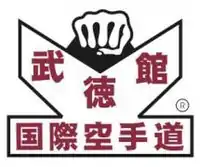Gosoku-ryu
Gosoku-ryū (剛速流) is a style of karate which was founded by Takayuki Kubota.[1] Gosoku stands for hard and fast, which suggests a combination of techniques both from the fast and dynamic Shōtōkan style as well as from the strength-focused Gōjū-ryū style.
 | |
| Also known as | Gosoku Ryu, Go Soku ryu |
|---|---|
| Country of origin | |
| Founder | Takayuki Kubota |
| Current head | Takayuki Kubota |
| Arts taught | Karate • kobudo |
| Ancestor schools | Shōtōkan • Gōjū-ryū |
| Practitioners | James Caan, Rod Kuratomi, Val Mijailovic, Takemasa Okuyama, Grant Campbell, Natasha Inuhaere, Mike Ireland |
| Official website | ikakarate |
Background
The International Karate Association (IKA) was formed in Tokyo, Japan in 1953 for the purpose of teaching and promoting the Gosoku style of karate.[1] Gosoku-ryū, "the style of force with speed", incorporates the methods of Goju-ryū and Shotokan karate with aikido, jujitsu, and judo. It is applied so as to encompass any attacker from all angles.
In 1964, Kubota came to the United States. He was able to gather several talented young men to create the nucleus of the U.S. branch. Under Kubota's tutelage, the IKA has achieved wide recognition in the martial arts world. Members of the organization have won championship titles, including California state, U.S. national, and world championships. The IKA reaches worldwide with headquarters located in Glendale, California.
Belt system
Advancement through the ranks, as marked by belt color, is a process signifying progressively greater control and coordination of mind and body. The length of time involved is largely dependent upon the dedication of the individual student.
The progressive ranks of karate are reflected in the different colored belts. There are two major classifications: the ranks of black belt are called dans, while all those below the rank of black belt are kyus.
In Gosoku-ryū, there are ten[2] kyu ratings, as follows:
| Lowest | ||||||||||||||||||||||
| 10th Kyu | White | |||||||||||||||||||||
| 9th Kyu | Yellow Belt | |||||||||||||||||||||
| 8th Kyu | Orange Belt | |||||||||||||||||||||
| 7th Kyu | Blue Belt | |||||||||||||||||||||
| 6th Kyu | Purple Belt | |||||||||||||||||||||
| 5th Kyu | Green Belt | |||||||||||||||||||||
| 4th Kyu | Green Belt | |||||||||||||||||||||
| 3rd Kyu | Brown Belt | |||||||||||||||||||||
| 2nd Kyu | Brown Belt | |||||||||||||||||||||
| 1st Kyu | Brown Belt | |||||||||||||||||||||
| Highest | ||||||||||||||||||||||
After achieving shodan, or first degree black belt ranking, a karateka may progress further though the dan ranks up to ju-dan, or tenth degree black belt.
| Lowest | ||||||||||||||||||||||
| 1st Dan | Black Belt 1st Dan | |||||||||||||||||||||
| 2nd Dan | Black Belt 2nd Dan | |||||||||||||||||||||
| 3rd Dan | Black Belt 3rd Dan | |||||||||||||||||||||
| 4th Dan | Black Belt 4th Dan | |||||||||||||||||||||
| 5th Dan | Black Belt 5th Dan | |||||||||||||||||||||
| 6th Dan | Black Belt 6th Dan | |||||||||||||||||||||
| 7th Dan | Black Belt 7th Dan | |||||||||||||||||||||
| 8th Dan | Black Belt 8th Dan | |||||||||||||||||||||
| 9th Dan | Black Belt 9th Dan | |||||||||||||||||||||
| 10th Dan | Black Belt 10th Dan | |||||||||||||||||||||
| 10th Dan | Ju-dan | |||||||||||||||||||||
| Highest | ||||||||||||||||||||||
The ju-dan sometimes wears a red belt to distinguish him or herself. Instructors that are 4th dan are sometimes awarded the title of "Shihan-Dai" (deputy master). Instructors that are 5th dan or higher are sometimes awarded the title of "Shihan" (master instructor). Title is not always awarded by rank alone. One must be an active instructor and be awarded the rank by Kubota.
Major differences from other styles
Gosoku-ryū is similar to Shotokan karate. It differs from Shotokan in that it incorporates the linear power movements of Shotokan with the speed and soft circular motions of Gōjū-ryū. The meaning of Gosoku-Ryu is "Hard and fast". Emphasis is put on practical application and sparring. Stances are generally shorter when in defensive positions and transition to longer stances when power moves are delivered. During kicks, including kihon, hands are kept in guard (and not spread aside). Gosoku-ryū teaches quick leg sweeps and take-downs; in kumite, attacks often end on the floor. Fast footwork which adds speed and power by utilizing the rotation of the hip makes Gosoku-ryū different from other styles. Gosoku-ryū also incorporates aikido, judo, and jujitsu techniques, which are used in ground fighting and for control and restraint techniques that are taught to law enforcement.
Kobudo weapons
Many weapons are practiced in the dojo: Kubotan, Tonfa, Kama, Jō, Bokuto, Bokken, Shinai, Tsue (walking cane), and the Katana (Japanese sword).[3] Kubota trained with Taira Shinken learning ancient Kobudo katas while developing his own for his school. The Kobudo kata created by him include:[3]
- Tonfa: Washi no kata, Juji no uke.
- Jō: Keibo jitsu, Ken shin ryū.
- Tsue (walking cane): Tsue ichi no kata, ni no kata, san no kata, yon no kata, go no kata, roku no kata, Mawashi no kata.
- Katana (created by Kubota): Sankaku giri, Atemi no kata, Kubo giri, Gyaku giri, Iaido ichi no kata, ni no kata, san no kata, Toshin.
- Bokken: Ken no Michi, Ken no Mai
Prominent students
References
- "History of Gosoku Ryu". ika-alaska. Retrieved 2022-11-09.
- Kubota, Tak (2002). Fighting Karate Gosoku Ryu. Burbank, CA: Unique Publications. p. 27. ISBN 0-86568-205-4.
- Warsaw Karate Center (in English)
- Hank Hamilton's profile. Hypnosis.edu. Retrieved on 2012-01-07.
- IKA Newsletter. Ikakarate.com. Retrieved on 2012-01-07.
- "Gosuku Kai | Facebook". Facebook. July 29, 2014.
- "Budokan Rotorua". Budokan Rotorua. Retrieved November 9, 2022.
- "Te Ashi Kai Shin Karate-do". takskarate.com.au. Retrieved November 9, 2022.
- "Kancho Bio". Japan Martial Arts Center.
External links
- www.IKAKarate.com
- www.karatesensei.com
- Japan Martial Arts Centre website
- International Gosoku-Ryu Karate-Do Association